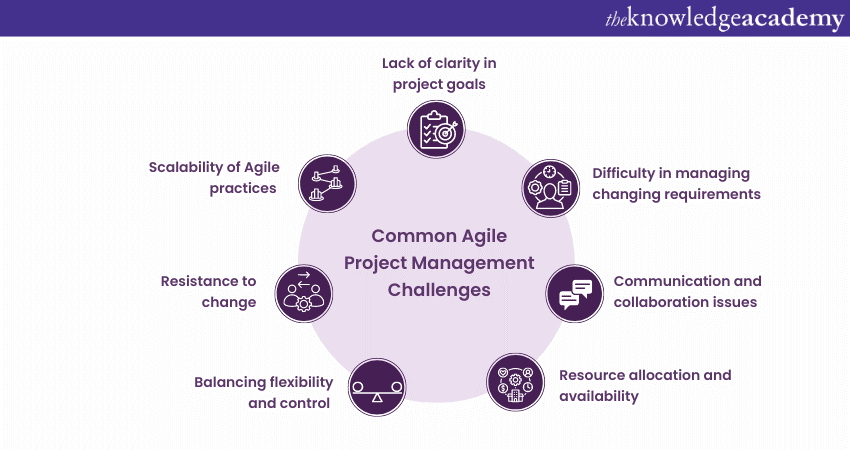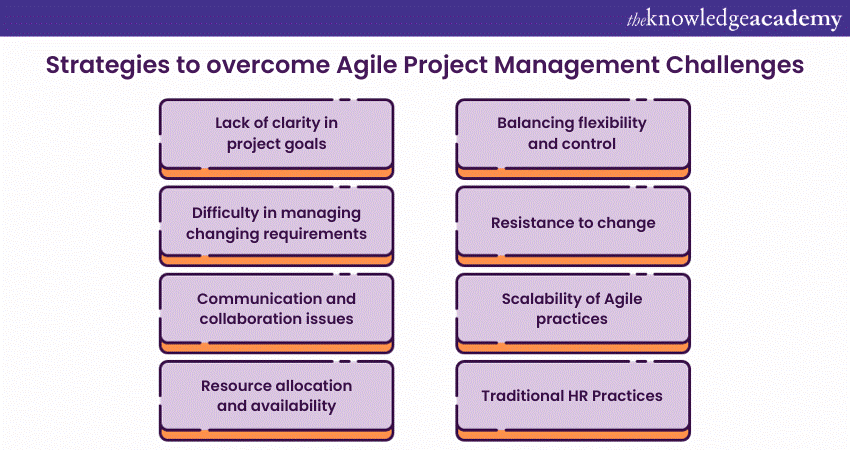We may not have the course you’re looking for. If you enquire or give us a call on 01344203999 and speak to our training experts, we may still be able to help with your training requirements.
Training Outcomes Within Your Budget!
We ensure quality, budget-alignment, and timely delivery by our expert instructors.

Every modern organisation aims to streamline operations and enhance efficiency to maintain a competitive edge in the market. This is why Agile Project Management, based on the Agile model, has gained significant popularity in recent years, owing to its ability to enhance flexibility, adaptability, and customer satisfaction in project delivery. However, like any Project Management methodology, Agile Project Management is not without its challenges. Agile project management can deliver numerous benefits to IT firms. When implementing the agile strategy, firms face several hurdles and issues.
In this blog, we will explore some common Agile Project Management Challenges and discuss strategies to overcome them effectively.
Table of Contents
1) Introduction to Agile Project Management
2) Common Agile Project Management Challenges
a) Lack of clarity in project goals
b) Difficulty in managing changing requirements
c) Communication and collaboration issues
d) Resource allocation and availability
e) Balancing flexibility and control
f) Resistance to change
g) Scalability of Agile practices
h) Traditional HR Practices
3) Strategies to overcome Agile Project Management Challenges
4) Conclusion
Introduction to Agile Project Management
Agile Project Management is essentially an iterative approach to managing projects that emphasises collaboration, flexibility, and continuous improvement. The methodology, when implemented in Project Management, focuses on delivering value to customers through frequent iterations and feedback loops. Agile teams work in short-term cycles called Sprints, where they plan, execute, and review their work. Agile Project Management enables project teams to respond to changes quickly, deliver high-quality products, and foster continuous learning and adaptation.

Common Agile Project Management Challenges
Agile Project Management, despite its numerous advantages, can face several challenges that project teams need to overcome to ensure successful project delivery. This section of the blog will delve deeper into some commonly encountered Agile Project Management Challenges:

a) Lack of clarity in project goals
One of the primary Agile Project Management Challenges is the lack of clarity in project goals. As Agile projects typically involve iterative development and evolving requirements, it can be challenging to define and prioritise project objectives. This ambiguity can lead to misunderstandings, misalignment, and the inability to deliver the desired outcomes.
To address this challenge in Agile Project Management, Project Managers must invest time in clarifying project goals, ensuring alignment among stakeholders, and setting clear expectations from the start.
b) Difficulty in managing changing requirements
Difficulty in managing changing requirements is one of the main challenges in Agile Project Management. Agile embraces changing requirements as it values customer collaboration and responsiveness. However, managing these changing requirements can be a challenge.
Frequent changes may impact project timelines, resource allocation, and team morale. Project Managers need to establish effective change management processes to assess the impact of new requirements, prioritise changes, and communicate them transparently to the team. This helps maintain focus, manage expectations, and minimise disruption caused by evolving Agile Project Management requirements.
c) Communication and collaboration issues
Effective communication and collaboration are considered essential for the success of Agile Project Management. However, challenges can arise when team members are geographically dispersed, work in different time zones, or have varying communication preferences.
Inadequate communication can lead to misunderstandings, delays in decision-making, and reduced productivity. Project Managers must foster an environment that promotes open communication, encourages regular team interactions, and utilises appropriate collaboration tools. By doing so, Agile Project Management can overcome communication challenges and ensure seamless collaboration among team members.
d) Resource allocation and availability
Agile Project Management requires dedicated resources to deliver value in short iterations. However, resource allocation and availability can become significant challenges, especially in large organisations or when team members are involved in multiple projects simultaneously.
Conflicting priorities and limited availability can hamper project progress and jeopardise the achievement of project goals. Project Managers must work closely with Resource Managers to ensure adequate resource allocation, manage competing demands, and optimise resource utilisation. Effective resource planning and allocation strategies help Agile Project Management overcome these challenges and maintain project momentum.
e) Balancing flexibility and control
Agile Project Management emphasises flexibility and adaptability, allowing for quick adjustments based on customer feedback and changing market dynamics. However, striking the right balance between flexibility and control can be challenging. While too much control can stifle creativity and innovation, excessive flexibility can lead to scope creep, missed deadlines, and project instability.
Project Managers need to establish a framework that provides enough structure and control while allowing room for flexibility and innovation. This balance ensures that the project stays on track while leveraging the benefits of Agile methodologies.
f) Resistance to change
Agile Project Management introduces a shift in mindset, processes, and roles within traditional Project Management environments. Resistance to change is one of the common challenges faced by teams adopting Agile practices. Some team members may be resistant to abandoning established processes, adjusting to new roles, or embracing a more collaborative and iterative approach.
To address this challenge, Project Managers need to provide proper training and education about Agile principles. In addition, they must foster a culture of continuous learning and actively involve team members in the decision-making process. This helps overcome resistance and ensures a smooth transition to Agile Project Management.
g) Scalability of Agile practices
While Agile methodologies originally originated from small, co-located teams, organisations today often need to scale Agile practices to larger and distributed teams. Scaling Agile Project Management introduces additional complexities and challenges. These challenges include coordinating efforts across multiple teams, aligning priorities, and maintaining consistent communication and collaboration.
Project Managers should adopt appropriate scaling frameworks, such as Scaled Agile Framework (SAFe) or Large-Scale Scrum (LeSS). This helps ensure the effective implementation and coordination of Agile practices at the enterprise level. It also facilitates smooth scalability and maximises the benefits of Agile Project Management across the organisation.
h) Traditional HR Practices
HR divisions should use agile practices when employing, examining, and encouraging staff members. Agile is a valuable method of performing since it promotes the participation of the right people in projects rather than depending on pre-existing roles or job definitions. People will volunteer as they feel capable and knowledgeable in the project's field and have specified working relationships with others who share their confidence.
These individuals are helpful to the project as they are encouraged more by a fascinating assignment or challenge, operating with a particular group or leader, than by accepting pay or other temporal advantages. Agile businesses must revise their incentive and performance plans to accommodate team-based learning.
Strategies to overcome Agile Project Management Challenges
Agile Project Management brings its own set of challenges, but with the right strategies, these challenges can be effectively addressed. Here are some strategies to overcome the common Agile Project Management Challenges:

1) Lack of clarity in project goals
a) Clearly define project goals: Work closely with stakeholders to define and document clear project goals at the outset. This helps make sure that everyone is on the same wavelength and understands what needs to be achieved.
b) Prioritise and communicate goals: Rank the project goals based on their importance and communicate them to the team. Regularly revisit and refine the goals as the project progresses.
2) Difficulty in managing changing requirements
a) Embrace Agile principles: Embrace the Agile mindset of embracing change and view changing requirements as opportunities to deliver increased value to the customer.
b) Implement effective change management: Establish a structured change management process to assess, prioritise, and incorporate changes into the project. Communicate changes transparently to the team and stakeholders.
3) Communication and collaboration issues
a) Foster open communication: Create an environment that encourages open communication and frequent collaboration. Use appropriate communication tools and platforms to facilitate seamless information sharing.
b) Conduct regular stand-up meetings: Conduct daily or regular stand-up meetings where team members share updates, discuss roadblocks, and collaborate on solutions. This promotes alignment and keeps everyone informed.
4) Resource allocation and availability
a) Prioritise resource allocation: Work closely with Resource Managers to prioritise and allocate resources effectively. Identify critical project roles and ensure that they have the necessary time and availability to contribute to the project.
b) Optimise resource utilisation: Continuously monitor resource utilisation and identify any bottlenecks or overloading. Distribute workload and balance resource allocation to ensure efficient project execution.
5) Balancing flexibility and control
a) Establish clear project guidelines: Define project boundaries, processes, and decision-making frameworks to provide the necessary structure and control. This helps strike a balance between flexibility and control.
b) Empower the team: Empower team members to make decisions within their areas of expertise. Encourage innovation and creativity while ensuring that the decisions align with project objectives.
6) Resistance to change
a) Provide Agile training and education: Offer training sessions and workshops to familiarise team members with Agile principles, methodologies, and practices. Educate them about the benefits and outcomes of Agile Project Management.
b) Lead by example: Demonstrate the benefits of Agile by implementing Agile practices in a visible and successful manner. Encourage team members to adopt Agile practices gradually and provide support throughout the transition.
7) Scalability of Agile practices
a) Adopt scaling frameworks: Explore and implement scaling frameworks like Scaled Agile Framework (SAFe) to effectively scale Agile practices across larger projects or organisations. These frameworks provide guidelines and best practices for coordination and collaboration.
b) Foster cross-team communication: Encourage communication and collaboration among different Agile teams working on related projects. Facilitate knowledge sharing and alignment of priorities to ensure consistency and synergy.
8) Traditional HR Practices
a) Foster team building: Agile is a valuable method of performing since it promotes the participation of the right people in projects rather than depending on pre-existing roles or job definitions.
b) Relationship and communication building: People will volunteer as they feel capable and knowledgeable in the project's field and have specified working relationships with others who share their confidence.
Conclusion
All in all, even though there are several Agile Project Management Challenges – they are not insurmountable. By implementing the right strategies, as mentioned above, Project Managers can address these challenges effectively. An organisation must consider both the many benefits and challenges of Agile Project Management before committing to the methodology.
Unleash the true power of Agile Project Management with our Agile Project Management Foundation and Practitioner (AgilePM) Course now!
Frequently Asked Questions
Upcoming Project Management Resources Batches & Dates
Date
 Agile Project Management Foundation (AgilePM®)
Agile Project Management Foundation (AgilePM®)
Sat 4th May 2024
Tue 7th May 2024
Mon 13th May 2024
Mon 20th May 2024
Tue 28th May 2024
Mon 3rd Jun 2024
Mon 10th Jun 2024
Sat 15th Jun 2024
Mon 17th Jun 2024
Mon 24th Jun 2024
Mon 1st Jul 2024
Mon 8th Jul 2024
Sat 13th Jul 2024
Mon 15th Jul 2024
Mon 22nd Jul 2024
Mon 29th Jul 2024
Sat 3rd Aug 2024
Mon 5th Aug 2024
Mon 12th Aug 2024
Mon 19th Aug 2024
Tue 27th Aug 2024
Mon 2nd Sep 2024
Sat 7th Sep 2024
Mon 9th Sep 2024
Mon 16th Sep 2024
Mon 23rd Sep 2024
Mon 30th Sep 2024
Sat 5th Oct 2024
Mon 7th Oct 2024
Mon 14th Oct 2024
Mon 21st Oct 2024
Mon 28th Oct 2024
Sat 2nd Nov 2024
Mon 4th Nov 2024
Mon 11th Nov 2024
Mon 18th Nov 2024
Mon 25th Nov 2024
Mon 2nd Dec 2024
Mon 9th Dec 2024
Sat 14th Dec 2024
Mon 16th Dec 2024







 Top Rated Course
Top Rated Course


 If you wish to make any changes to your course, please
If you wish to make any changes to your course, please


